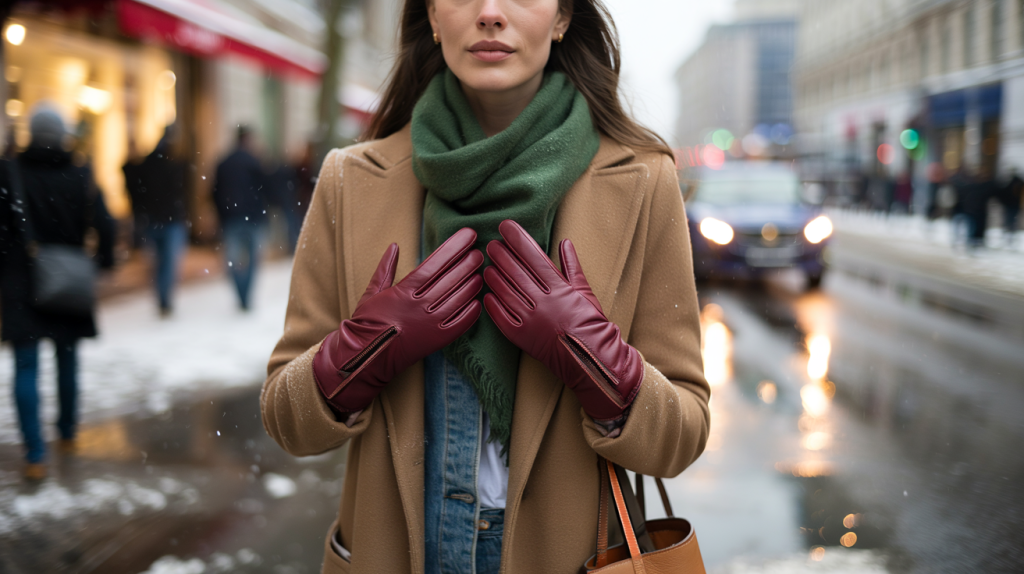Cold bites, outfits stall, then a simple switch rewrites the story: women’s leather gloves. One polished pair sharpens a winter silhouette, keeps hands warm, and signals quiet luxury without trying too hard.
The best part: choosing well is easy. Smooth nappa or velvety suede, short wrist or opera length, cashmere or silk linings, even touchscreen fingertips. A smart pick looks sleek on a Monday commute and still feels right for a late dinner. Here is how to land the pair that flatters and lasts.
Women’s leather gloves for a winter look that feels instantly elevated
The main idea is simple: leather adds structure. Knit beanies, bulky puffers, wide scarves can read casual. Leather gloves pull focus back to clean lines, so the whole look breathes elegance instead of heaviness.
Observation from the street on a wet Tuesday: dark wool coat, sneakers, tote, nothing wrong. Add black nappa gloves and the outfit suddenly looks tailored. Color works too. Burgundy or forest green warms camel coats. Chocolate teams with navy. Cream lifts grey, while tan wakes up all-black.
The problem many run into is comfort. Gloves look chic but feel stiff. That is a fit issue. Measure hand circumference at the knuckles in inches; traditional women’s glove sizes usually range from 6 to 8.5, a method used by heritage makers such as Dents and Hestra. A snug start is normal, since leather eases with wear, though fingers must move freely from day one.
Materials, linings and safety standards you can actually trust
Full-grain or top-grain leather brings the best balance of softness and longevity. Nappa finishes look polished, suede reads matte and cozy. For warmth, linings matter: cashmere for light, breathable insulation; wool blends for everyday cold; silk for dressy evenings; fleece for budget warmth.
There is also the question of skin safety. Under EU REACH Annex XVII, a limit of 3 mg/kg of chromium VI applies to leather articles that touch the skin, in force since 2015, cited by the European Chemicals Agency. Shoppers can look for brands that test to that requirement.
Two quick quality signals help. The Leather Working Group, founded in 2005, audits tanneries on environmental performance. OEKO-TEX introduced its LEATHER STANDARD in 2016 to test for potentially harmful substances. For technical warmth claims, the European standard EN 511:2006 rates protective gloves against cold on scale levels from 0 to 4 for convective and contact cold, useful when brands publish certified results.
Outfit ideas: styling women’s leather gloves that work every day
Most wardrobes already have the pieces. The trick is the pairing.
- Camel coat, indigo denim, white sneaker, dark brown nappa gloves : soft contrast, office to brunch.
- Black wool blazer, charcoal knit, tailored trousers, black gloves : minimal, sharp, no effort needed.
- Puffer jacket, straight jeans, ankle boots, burgundy gloves : color pop that reads grown-up.
- Long knit dress, tall boots, tan gloves : smooth lines, weekend to dinner.
- Evening coat, silk scarf, cream leather gloves : light against dark, instantly dressy.
Color rhythm helps. Match gloves to shoes for cohesion, or echo bag hardware with glove shade. Short wrists feel modern with puffers; mid-forearm pairs seal drafts under cocoon coats; opera lengths hide under wide sleeves for drama without shouting.
Care, longevity and the small upgrades that change everything
Leather loves routine. After rain or snow, pat dry, then let gloves air on a flat surface away from a radiator. A simple cedar shoe tree nearby can absorb closet moisture. Occasional leather balm keeps nappa supple; suede responds to a soft brush, then a water-repellent spray.
Touchscreen fingertips solve the mid-commute juggle. For cyclists and early commuters, a thin merino liner adds warmth without bulk and preserves the leather interior. If a pair costs 120 euros and gets 90 winter wears across three seasons, that is roughly 0.44 euro per wear, a calm argument for quality.
When warmth needs climb, read labels. Some fashion gloves publish EN 511 results, which helps compare real insulation. For sensitive skin, brand pages often reference OEKO-TEX LEATHER STANDARD certificates, and many note Leather Working Group audited sourcing. Those three pieces – fit, independent testing, basic care – turn a pretty accessory into a winter staple that keeps doing the job.
